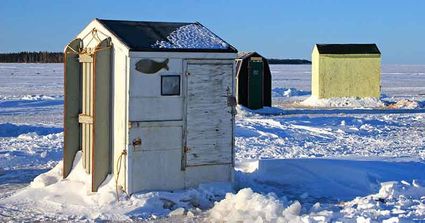Ice Fishing Season is Beginning, Anglers Encouraged to Practice Safety
It's that time of year when ice anglers are appearing on Montana's waters for the ice fishing season. Ice fishing is a great way to enjoy the winter weather and to catch some nice fish. However, Montana Fish, Wildlife and Parks remind ice anglers that safety should be the number one concern during a day out on the ice.
With the recent cold snap, there is fishable ice in some areas already. However, large bodies of water like Fort Peck Reservoir have yet to freeze over. While the first ice of the year often offers some of the best fishing, it also can be quite variable from location to location and from day to day.
Anglers should be familiar with the water body they plan to fish, or go with someone who knows that water and how ice tends to form and change there. The safest ice anglers are those who pay as much attention to the condition of the ice as they do the fishing conditions.
In FWP Region 6, there are dozens of water bodies that have windmills operating to keep dissolved oxygen flowing to fish and other aquatic life through the long winters. However, according to Havre-area Biologist Cody Nagel, it can also change the ice conditions.
"Anglers need to be extra careful about venturing onto any ice where these windmills are operating because the action of the aerators can weaken or thin the ice," Nagel said. "A good rule of thumb is that if you see a windmill operating out on a pond or reservoir, you should use extreme caution."
And when on the ice, remember:
• If you have even the slightest doubt about the safety of the ice-stay off it. No fish is ever worth a fall into frigid water.
• Blue ice is usually hard. Watch out for opaque, gray, dark or porous spots in the ice that could be weak, or soft areas.
Ice also tends to thin more quickly at the shorelines.
• The following are considered to be MINIMUMS needed with ice thickness:
4 inches: 1 person with gear
5 inches: small group spread out
6 inches: snowmobile or ATV
9 inches: small automobile*
12 inches: pickup truck or SUV*
*not recommended, but if you must, proceed at your own risk!
• Watch for pressure ridges. These are areas of open water or thin ice where the ice has cracked and heaved due to expansion from freezing.
• Test the ice ahead of you with an ice spud bar or an auger.
• Don't leave children unsupervised on the ice.
• Lakes and ponds do not freeze at the same thickness all over.
• Moving water-rivers, streams and springs-weaken ice by wearing it away from underneath. Avoid ice on rivers and streams, or where a river or stream enters a lake, pond or reservoir.
• The least safe ice usually occurs early and late in the season, when the weather is warmer.
Some other common ice-safety reminders to keep in mind include:
• Dress warm and waterproof to help prevent frostbite and hypothermia.
• Check in with a local sport shop or bait shop before you set out for a trip. They may have up-to-date information to share about the places you plan to fish.
• Check out ice conditions before you go. Ask other anglers or local sources and take into account changes in the weather during the past 24 hours.
• It's OK to wear a life jacket (PFD) or carry a throwable floatation device while out on the ice - safe ice-anglers do it all the time.
• Before you head from home, tell someone where you plan to fish and when you plan to return.
• Carry a pair of long spikes on a heavy string around your neck. That way, if you break through the ice, you can use the spikes to grip the ice and pull yourself out of the water.
Please follow these basic rules of ice safety, and have a good day out on the ice!




